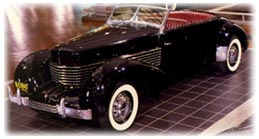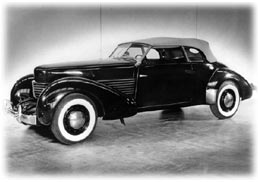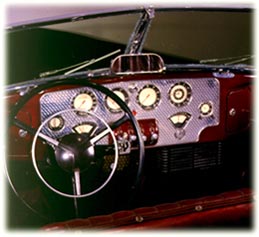
 |
The term "all-new" is often applied to automobiles, and is almost always an extreme exaggeration. In the case of the Cord it was absolutely true. Buehrig's styling was utterly unlike anything else in 1936. While other cars emphasized an upright radiator grille, the whole theme of the Cord was horizontal. The long coffin-shaped hood, the louvers wrapping around the front end from one side of the cowl to the other, the flowing fenders, the slanting vee-shaped windshield all drew the eye along the length of the car. The effect was enhanced by careful attention to details: headlights, door hinges, gas filler were all concealed. There were no running boards, and even the simple round tail-lights were flush mounted. On convertibles like this Phaeton, the effect was enhanced by a steel tonneau cover that completely hid the folded top. Photo: B.111394  
|
 | The Cord's instrument panel was a sharp contrast to the simplicity of the exterior. It is an eye-catching combination of engine-turned fascia, chrome gauge bezels, and aircraft-type switches. It is often described as the most beautiful ever installed on an American car. The panel is a study in symmetry. The four large round dials are, from left to right speedometer, tachometer, oil pressure, and clock. At the left end of the panel is the round water temperature gauge, while the right end holds the round radio dial, and the radio controls. The fan-shaped gauge on the left reports on oil and fuel levels. It is balanced on the right by a fan-shaped ammeter. At the center bottom of the panel are four levers (l. to r. ) headlights, throttle, choke, and dash lights. At the far ends of the dash are the cranks that operate the hidden headlights. Even the steering wheel is different, sporting one of the first horn rings ever seen on an American car. Jutting from the right side of the steering column is the chromed, gated switch for operating the transmission. Photo: B.111396 
|
